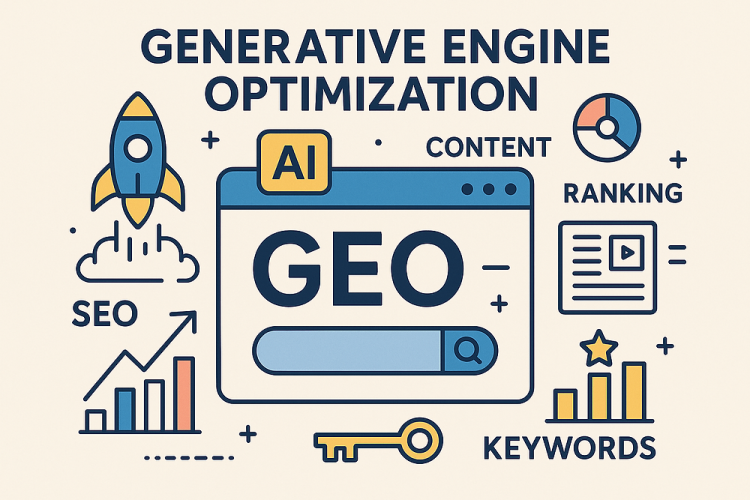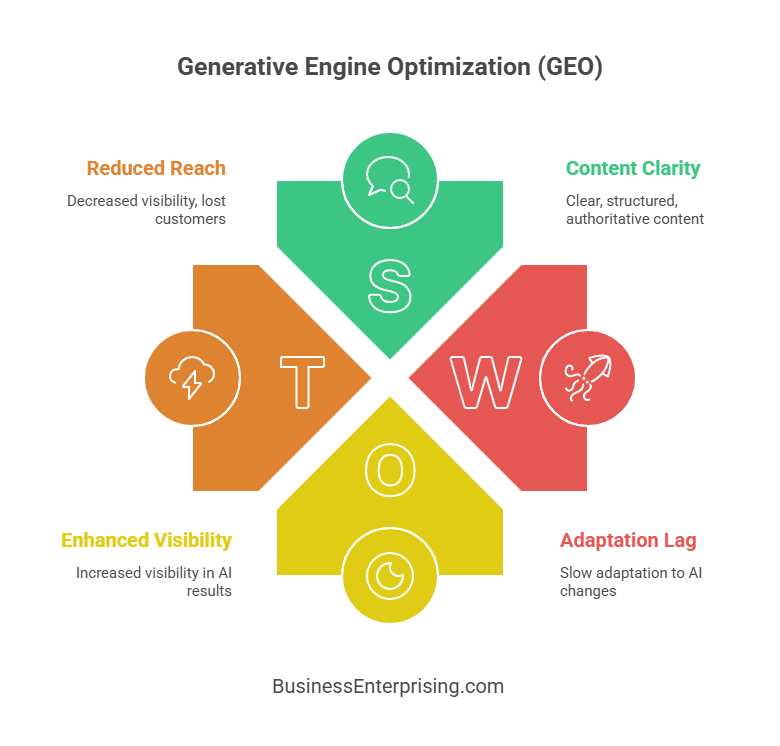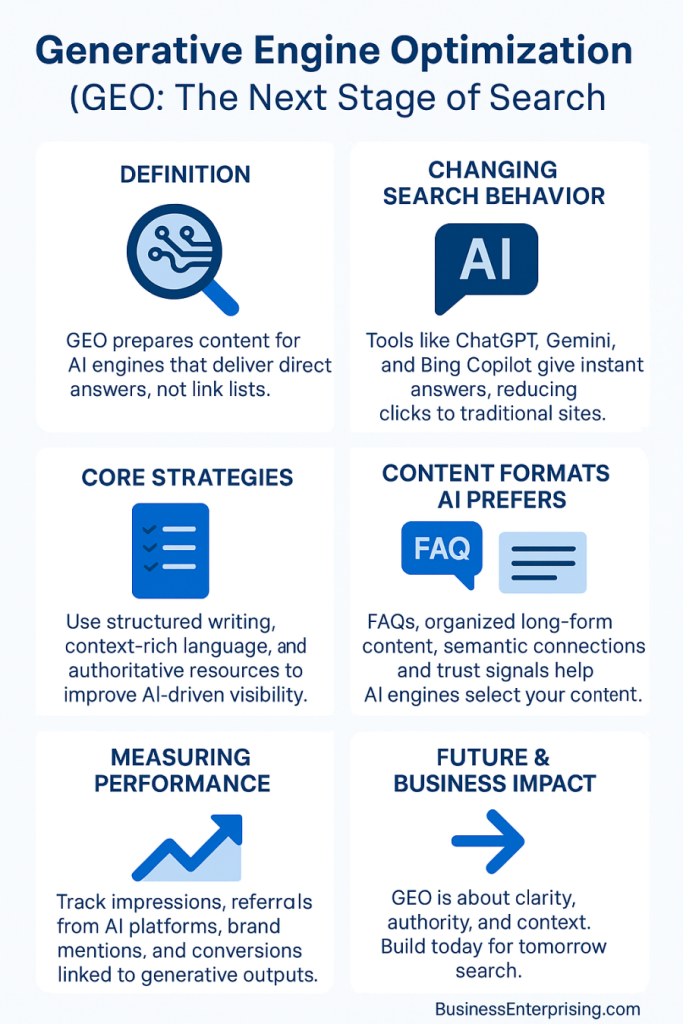
Additionally, customers now expect faster, clearer answers without scrolling through endless pages. Tools like ChatGPT, Gemini, and Bing Copilot are shaping that behavior. Therefore, your visibility depends on how easily these systems can pull and present your content. If your material lacks clarity, you risk being excluded from results entirely.
Generative AI favors content that is structured, context-rich, and trustworthy. That means you must go beyond basic keyword targeting. Instead, you should focus on creating resources that add value and reflect real expertise. Therefore, strong organization, FAQs, and in-depth articles play a greater role than before.
Your business benefits when you anticipate these changes instead of reacting later. However, adapting requires consistent effort and a willingness to rethink your approach. By treating generative platforms as part of your marketing plan, you increase the chances of staying visible where customers search.
Additionally, blending GEO with traditional SEO gives you a balanced strategy. You keep your presence in search engines while preparing for future channels of discovery. Therefore, adopting these practices now can strengthen your brand and protect your reach as technology advances.
What is Generative Engine Optimization?
Generative Engine Optimization is an approach to digital marketing that focuses on how AI-powered engines present information to users. Traditional search engines provide lists of links, but generative engines create answers directly from multiple sources. Therefore, the way you structure your content now affects whether AI highlights your business in those answers.
Additionally, GEO differs from SEO because the audience is no longer browsing through dozens of results. Instead, users rely on synthesized responses. That shift changes the importance of context, clarity, and authority in your writing. Therefore, content that is vague or poorly structured may not be selected by AI tools.
You should think of GEO as preparing your information for machines that speak to humans. These systems look for content that is easy to interpret, trustworthy, and consistent. Therefore, your site needs well-written articles, FAQs, and data-rich resources. The goal is to help AI engines confidently use your material when forming responses.
Businesses that adapt early gain visibility where customers are searching for fast answers. However, ignoring this change may reduce your reach even if your traditional SEO is strong. AI-driven search will continue to influence customer behavior. Therefore, optimizing for generative engines gives your business a chance to stay present in those conversations.
By focusing on clarity and authority, you prepare your brand for the future of online discovery. GEO does not replace SEO, but it adds another layer of strategy. Therefore, investing in both approaches helps your business stay relevant as technology evolves.
How Generative AI Changes Search Behavior
Generative AI has changed the way people search online. Instead of scrolling through long lists of links, users now receive direct answers. Tools like ChatGPT, Gemini, Perplexity, and Bing Copilot summarize information into short, clear responses. Therefore, your content needs to be structured so these engines can interpret and include it.
Additionally, this shift means fewer opportunities for users to land on your site by chance. When the answer appears in front of them, they may not click further. Therefore, you must think about how your brand can appear within those synthesized results. Visibility now depends on how well your information is recognized as reliable.
Content strategy must evolve to meet this change. Generative AI favors clear, well-organized writing with strong context. It looks for content that provides answers without confusion. Therefore, long, poorly structured text is less likely to be used. Short, precise explanations backed by detail are more effective.
Generative Engine Optimization helps you prepare for this new reality. It’s about making your content easy for AI to process and use. Additionally, it emphasizes authority and accuracy, which builds trust with both AI and potential customers. By optimizing for these systems, you increase your chance of being included in their outputs.
However, ignoring these changes can reduce your visibility even if your traditional SEO remains strong. Customers may never reach your site if AI excludes you. Therefore, adapting your strategy now positions your business where customers are already searching for quick answers.
Core Strategies for GEO Success
Success with Generative Engine Optimization depends on how you create and present your content. AI-driven tools prefer material that is clear, structured, and authoritative. Therefore, you need to think about readability as much as you think about keywords. Short paragraphs, logical flow, and direct language make it easier for AI systems to interpret your work.
Additionally, context matters more than ever. Engines pull information from multiple sources to build their responses. Therefore, your content should include detailed explanations, examples, and definitions where appropriate. The goal is to make your material complete enough that AI can confidently reference it. When you give more context, your brand has a better chance of appearing in generated results.
Authoritative resources are another key factor. AI favors content that reflects expertise and reliability. Therefore, you should create guides, how-tos, and well-researched articles that stand above surface-level summaries. Adding original insights or practical tips helps position your content as trustworthy. Over time, consistent authority signals improve your inclusion in AI-generated answers.
You also need to balance human readability with machine clarity. While you write for people, AI systems must parse your structure. Therefore, headings, subheadings, and clear formatting become valuable tools. The easier it is for AI to scan and extract meaning, the more likely it will use your content.
Generative Engine Optimization is not about replacing traditional SEO but expanding it. By focusing on clarity, context, and authority, you prepare your business for the next stage of search. Therefore, adopting these strategies now will keep you visible as generative engines continue shaping how people discover information.
Content Formats AI Prefers
AI-powered engines respond better to certain formats, which means your content strategy must adapt. Short, clear sections with direct answers often work best. Therefore, FAQs are especially valuable. They provide concise responses to common questions, making it easy for AI to identify and reuse your content.
Additionally, long-form articles still matter, but structure is critical. Break content into organized sections with headings and subheadings. Therefore, AI can scan and extract meaning quickly. A clear flow also helps readers engage without losing focus. Both audiences benefit when your writing balances depth with readability.
Semantic relevance is another factor. AI tools look for related terms and concepts that show context. Therefore, you should use language that connects ideas naturally. This approach helps engines see your content as informative rather than isolated. The richer the context, the more useful your material becomes for AI-driven answers.
Trust signals also play a role. Engines prefer sources that appear reliable and authoritative. Therefore, your content should be accurate, consistent, and supported by experience. You build trust when you publish resources that reflect real expertise. Over time, this makes AI more likely to feature your brand in responses.
Generative Engine Optimization relies on aligning your work with how AI systems evaluate content. When you create structured, context-rich, and trustworthy material, you improve your visibility. Therefore, adopting these formats positions your business to benefit from AI-driven discovery and customer engagement.
Measuring GEO Performance
Measuring the success of Generative Engine Optimization requires a focus on new signals that go beyond traditional SEO. You need to track how often AI-powered platforms reference your brand. Therefore, monitoring impressions from generative tools becomes an important part of your analysis. These insights show if your content is appearing in synthesized responses.
Additionally, referrals from AI platforms are another metric. Some engines provide links back to source material when generating answers. Therefore, reviewing referral traffic helps you understand which content is gaining visibility. Over time, these patterns reveal what type of material resonates with both AI and users.
Brand mentions are equally important. Generative engines may highlight your business without always sending direct traffic. Therefore, listening tools and monitoring systems can help capture when your brand appears in AI-generated outputs. These mentions signal growing authority, even if the clicks do not immediately show up.
Conversions remain the most meaningful measurement. You should track how many inquiries, sign-ups, or sales result from AI-driven visibility. Therefore, connecting these outcomes to your GEO strategy demonstrates real business value. Clear reporting also helps you refine content for better results.
Additionally, performance tracking allows you to compare GEO with your other marketing efforts. By watching these signals together, you can see where to invest more time. Generative Engine Optimization may not replace SEO, but it adds measurable value when approached strategically. Therefore, building the right system to track these signals will keep your business ahead of changes in search behavior.
Future of GEO and Business Impact
Generative Engine Optimization will continue to grow as AI-powered platforms become central to how people search for information. Traditional SEO is not going away, but its role will shift as generative engines handle more user questions directly. Therefore, businesses that adapt now will be better positioned to remain visible as search habits evolve.
Additionally, GEO will work alongside SEO rather than replace it. You still need search rankings to attract traffic, but you also need content that AI engines can interpret and highlight. Therefore, investing in both strategies creates balance. SEO drives visibility in traditional search, while GEO secures presence in AI-driven responses. Together, they cover the full spectrum of online discovery.
Early adoption matters. Businesses that shape their content for AI readability today will likely be the voices featured tomorrow. Therefore, acting now gives you an advantage over competitors who wait. Even small adjustments, like adding FAQs or improving structure, can increase your chance of being included in generative outputs.
Additionally, GEO may influence how brands measure authority. Mentions and visibility in AI-generated responses could become as important as rankings. Therefore, your content strategy should focus on clarity, context, and reliability. These qualities strengthen both traditional SEO and GEO efforts.
Generative Engine Optimization is not a passing trend. It reflects the direction of search technology and customer expectations. By preparing for that shift now, you protect your visibility and create space for growth. Therefore, businesses that act early will stay ahead as search continues to change.
Conclusion
Generative AI has already reshaped how people search for information, and its influence will continue to expand. Businesses that ignore this shift may see their visibility decline, even if they maintain strong traditional SEO. Therefore, it is wise to prepare your content now for both search engines and AI-driven tools.
Additionally, the principles behind Generative Engine Optimization encourage you to write with clarity, context, and authority. These qualities serve two purposes. They make your content more appealing to AI systems, and they also improve the experience for your human audience. Therefore, optimizing for generative engines benefits every visitor who interacts with your brand.
You should view GEO as an extension of your existing strategy, not a replacement. Traditional search optimization still matters, but AI-driven visibility requires added effort. Therefore, combining both approaches creates a balanced presence across multiple discovery channels. This dual focus keeps you prepared for shifts in technology and customer habits.
However, early action will make the biggest difference. Businesses that adapt sooner can secure positions in AI-generated results before competitors catch up. Therefore, small steps like structuring content more clearly or adding well-written FAQs can have lasting benefits. These changes build a foundation that supports growth across both current and future platforms.
Generative Engine Optimization is an opportunity to strengthen your digital strategy while positioning your business for what comes next. By acting now, you not only protect your reach but also open new paths for growth. Therefore, treating GEO as a priority today will pay off tomorrow.



